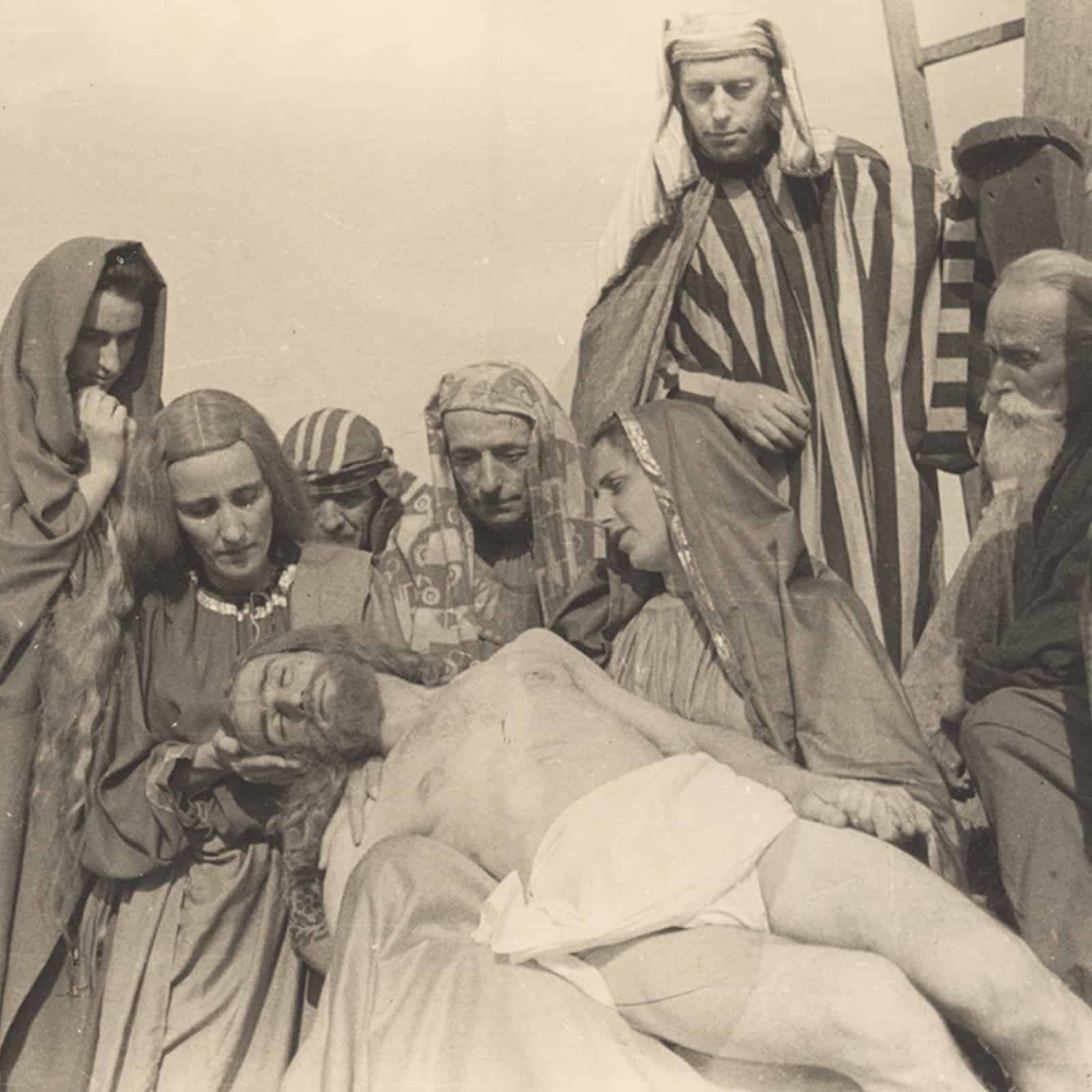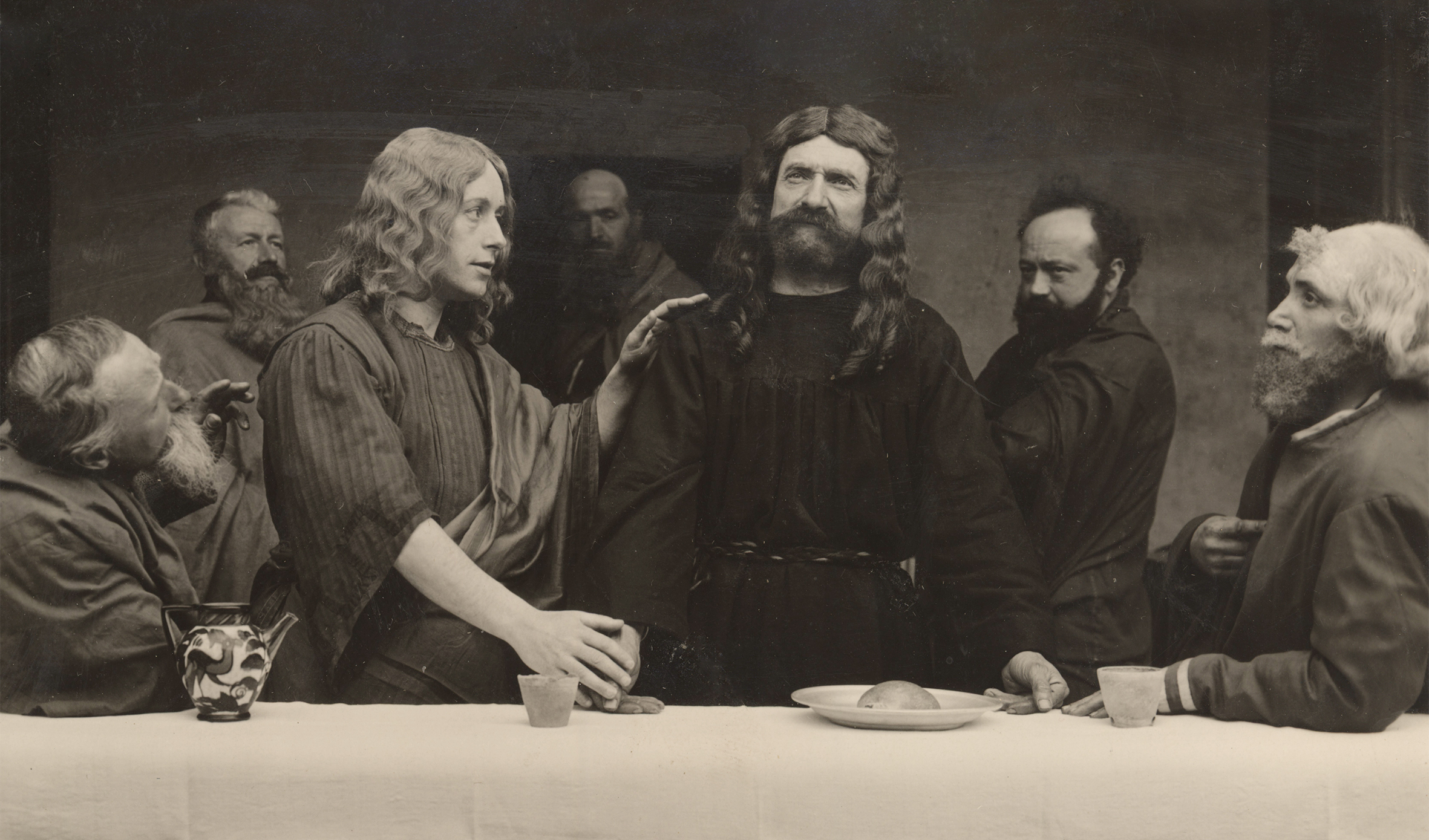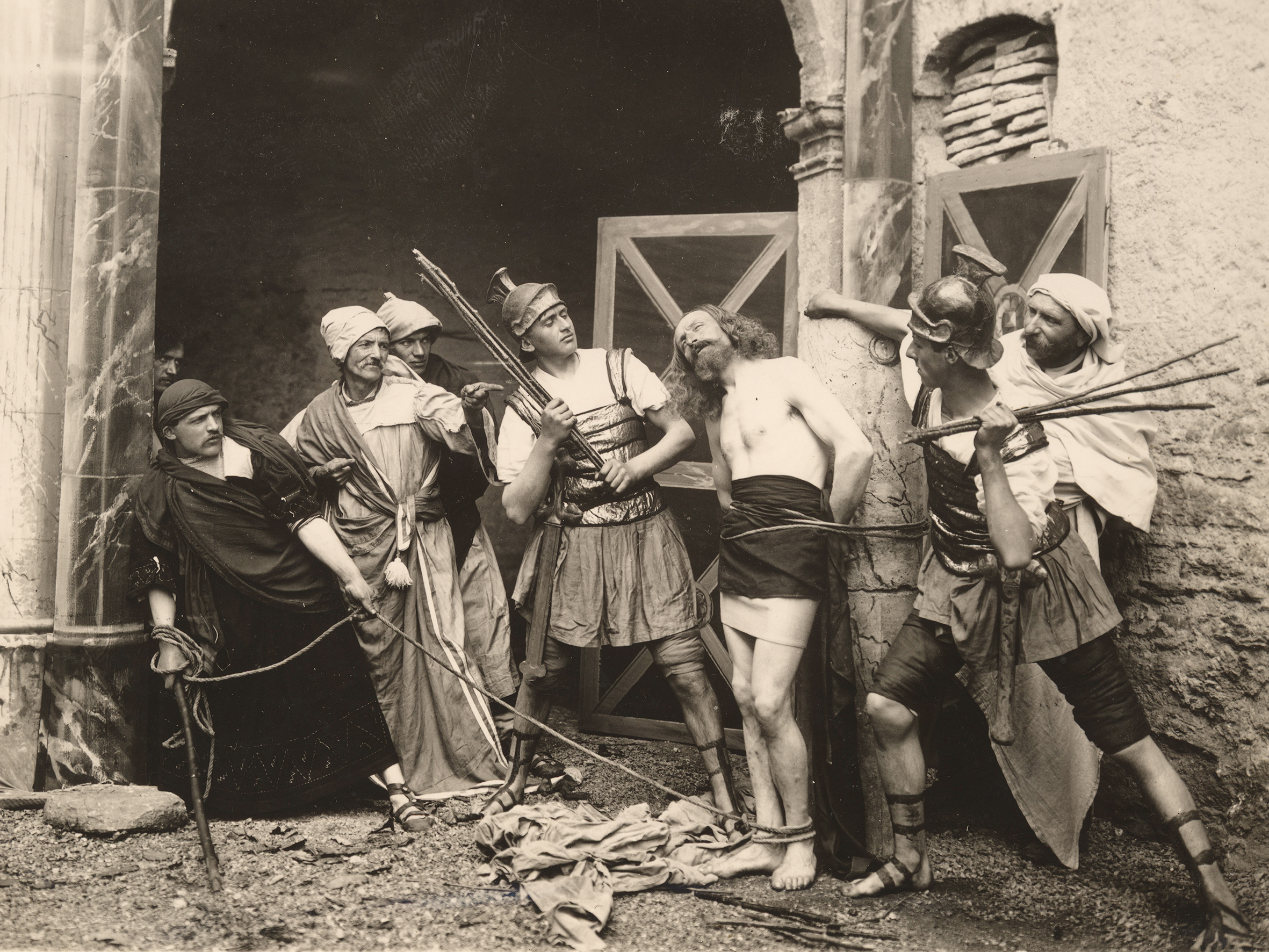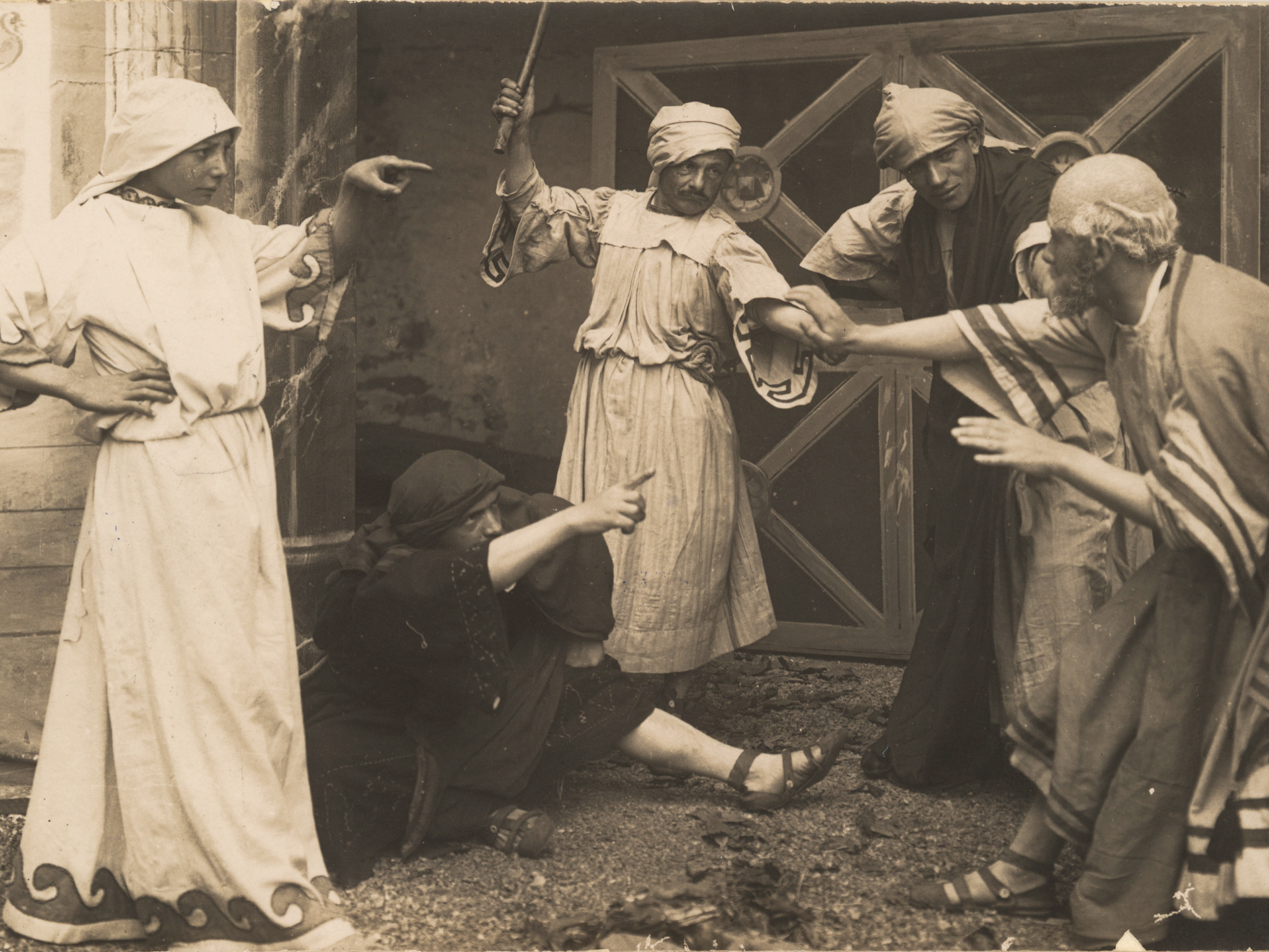Una potente rievocazione che ci arriva dal passato
La messa in scena sordevolese della Passione, secondo la tradizione popolare, compie duecento anni nel 2015. Tuttavia, molti elementi fanno pensare a origini più remote.
In questo scritto percorreremo il viaggio verso un possibile passato, non tratteremo perciò il periodo le cui rappresentazioni siano certificate sulla base di fonti attendibili con date certe, che sono tutte avvenute nell’Ottocento.
La ricerca di documenti sulla “prima Passione” di Sordevolo è diventata un po’ come quella del Sacro Graal. Tuttavia, quest’approccio, basato unicamente sul ritrovamento di un supporto documentale, difficilmente ci potrà dire quando essa ha avuto effettivamente origine, ma potrà solo aggiungere un’altra data alla serie di quelle conosciute. Inoltre, quest’approccio non prende in considerazione né l’ambiente culturale del Piemonte e, in senso più ampio, dell’Italia intera, né tantomeno la forte connotazione dell’identità religiosa di Sordevolo.
Nel Piemonte abbiamo testimonianze di rappresentazioni sacre, in particolare della Passione, precedenti alle rappresentazioni sordevolesi documentate, addirittura nel Quattrocento. Di due rappresentazioni della Passione avvenute in Torino, sappiamo le date: 1463 e 1468. A queste rappresentazioni si aggiunge un’altra ugualmente documentata che si è svolta in Revello presso Saluzzo tra il 1481 e il 1486.

…Così a Sordevol, che con voce pia
rinnova or la passione del signore
e or son cent’anni già quasù fioria
ritorna il popol con devoto amore…
– 1914, prof. Agostino Mersi
All’Archivio Capitolare di Santo Stefano in Biella abbiamo la testimonianza dal “Libro dei Conti del can. Giacomo Carrarino” che a Biella Piazzo il 4 luglio 1529 si è avuta la rappresentazione della vita di Abramo e della sommersione di Sodoma e Gomorra. Angelo Stefano Bessone, storico della chiesa biellese, ci racconta di una processione, detta delle “Angiolette”, organizzata dalla Compagnia della Dottrina Cristiana che risale al 1572, composta da cinquecento, seicento persone, in cui vengono rappresentati “qualche fatto del nuovo e dell’antico testamento”. Il vescovo Viancini la abolisce nel 1783, perché degenerata e ritenuta ormai priva di ogni valore religioso. Questo a dimostrare che, contrariamente a quanto sostenuto dallo storico Ricardo Adalgiso Marini, nel suo saggio del 1904, “La Passione di Gesù Cristo in Sordevolo”, anche nel Biellese vi sono rappresentazioni sacre prima del Settecento.
A Roma, tra la fine del Quattrocento e l’inizio del Cinquecento, la Compagnia del Gonfalone recita nel Colosseo un testo della Passione. La prima edizione a stampa esce a Roma nel 1500-1501. Il testo, come recita l’edizione romana, è stato “composto per più persone: misser Julianmo Dati fiorentino e per misser Bernardo di maestro Antonio Romano e per misser Mariano Perticappa”. Tuttavia, il grande studioso dei testi della nascita del teatro italiano nel Medioevo, Vincenzo De Bartholomaeis è convinto che i tre autori in realtà abbiano fatto una “semplice rabberciatura” di testi precedenti.
Di questo testo esistono diverse versioni, tra cui quella torinese del 1728.
Scrive Pier Francesco Gasparetto, drammaturgo, sceneggiatore e scrittore, che nel Cinquecento vi è “un grande, irripetuto momento di vita e di espressione artistica comunitaria […] Ora grandi città e piccole borgate vogliono la loro recita, il ciclo del Natale e quello della Passione, Il Giudizio Universale, i Miracoli e le Vite dei Santi”.
Come può Sordevolo essere estranea a questo movimento teatrale popolare, quando è capace dalla seconda metà del Cinquecento all’inizio del Settecento di costruire ben sette chiese con all’interno opere artisticamente di pregio, dimostrando non solo una spiccata propensione alla spesa per fini religiosi, che deriva da una forte cultura e fede cristiana, ma anche da un elevato livello di cultura artistica?
La prima traccia documentale di rappresentazioni sacre a Sordevolo è la Conversione di S. Agostino, del 1777. Difficile pensare che una rappresentazione di questo livello sia stata improvvisata se già non fosse stata presente una cultura teatrale e recitativa in grado di rappresentare un testo sacro così particolare e non certo parte della cultura popolare religiosa!
Sappiamo anche da Delfino Orsi, giornalista, letterato, storico e critico del teatro popolare piemontese, che a Sordevolo sono rappresentate fino a metà Ottocento Il Giudizio Universale e la Risurrezione, oltre che la Passione. Le prime due rappresentazioni richiedono “un assetto scenico complicato a molti e vari scompartimenti” e sono poi abbandonate nel 1850, quando si decide di rappresentare solo La Passione.

Questi fatti, unitamente alla constatazione di persistenza di tracce gianseniste nelle rappresentazioni ottocentesche della Passione di Sordevolo, tracce che non possono provenire che dal Settecento sordevolese, dove la presenza del giansenismo è ben documentato nella biblioteca parrocchiale, ci portano a pensare che le messe in scena della Passione avvengano almeno già nel Settecento. Nelle rappresentazioni fotografiche della Passione del 1866 e del 1891, infatti, le braccia del Cristo sembrano poste secondo l’iconografia del “crocefisso giansenista” dalle “braccia avare”, cioè una posizione asimmetrica con un braccio non aperto, quasi a indicare il piccolo numero degli eletti che possono entrare nel regno dei cieli.
Il Marini, come abbiamo accennato, sostiene che nel Biellese non si hanno rappresentazioni sacre prima del Settecento e pone come data, da cui si deve partire, il 1728, che abbiamo visto, è quella della pubblicazione in Torino del testo della Passione recitato a Roma nel Cinquecento dalla Compagnia del Gonfalone nel Colosseo. Questo perché, secondo il Marini, il testo recitato a Sordevolo è quella torinese del 1728, e aggiunge che su detta edizione si sono forgiati i testi delle Passioni biellesi.
Le Passioni cui accenna il Marini sono quelle di Occhieppo, di Andorno, di Cavaglià, di Romagnano e di Mongrando.
Le notizie documentate delle rappresentazioni sacre nella zona Biellese- Canavese si perdono all’inizio dell’Ottocento. La più antica la troviamo nell’alto Canavese, nella valle di Castelnuovo, a certificarla è Costantino Nigra, secondo cui vi è stata una Passione nel 1809.
Per quanto riguarda Sordevolo, l’affermazione del Marini, che, riferendosi a una prima data documentata, afferma che una “sola data certa, sicura, ricordata in documenti del Comune, è il 1816”, non è provata dai supposti documenti comunali.
Adalgisa Manza, ricercatrice, autrice della pubblicazione Le rappresentazioni sacre nel Biellese, del 1954, partendo dall’affermazione del Marini ha fatto una ricerca nell’Archivio Comunale di Sordevolo, non trovando però traccia di questi documenti, peraltro, come rileva giustamente la studiosa: “Imprecisati”.
All’esperienza della Manza si aggiunge la mia personale. La scrittura del mio libro “Sordevolo e la sua Storia”, mi ha, infatti, portato anche alla ricerca nell’Archivio Comunale di questi documenti. Il lavoro è partito dall’inventario attuale per poi passare a una verifica sistematica dell’archivio fisico. Il risultato è stato il rinvenimento di un’unica cartella il cui contenuto sia riferito alla Passione. I documenti, però, riguardano rendicontazioni di spettacoli d’inizio Novecento e problemi di ordine pubblico, infatti, la cartella si trova archiviata nella sezione Sicurezza Pubblica. Tuttavia, pensando che il Marini si riferisce all’Archivio di quando scrive, il 1904, e che nel frattempo possono esserci state variazioni, ho esaminato gli inventari del 1861, 1872 e 1874, conservati nell’Archivio attuale. In nessuno di questi inventari vi è un fascicolo inerente alla Passione. La Manza ha quindi fatto una ricerca accurata e perciò credo che ci si possa associare a lei nel dire che questi fantomatici e imprecisati “documenti del Comune”, siano “l’ingenuo espediente a cui forse taluno ricorse, per accrescere credibilità alle testimonianze verbali”.
Come già detto, non è quindi la strada delle datazioni documentali conosciute che ci conduce ad un inizio plausibile del teatro popolare religioso sordevolese, ma possono essere solo la ricostruzione e la corretta interpretazione dei documenti letterari e degli avvenimenti teatrali relativi all’ambiente culturale del tempo, che ci ha già portati almeno al Settecento sordevolese, a darci alcuni lumi sull’antichità del teatro sacro di Sordevolo.

Qui bisogna tornare al testo torinese del 1728, perché una copia è conservata presso l’Archivio Storico dell’Associazione Teatro Popolare di Sordevolo, per altro insieme con altri testi, tra cui un’altra edizione dello stesso testo del 1780 stampato a Venezia.
La presenza di questo testo significa che esso sia quello da cui è tratta la Passione di Sordevolo?
L’indizio è sicuramente stimolante, soprattutto perché l’Orsi, che è stato presente alla rappresentazione della Passione del 12 aprile 1891, nel libretto che scrive in seguito, “La Passione di Sordevolo”, afferma che “l’edizione seguita a Sordevolo è quella torinese, la quale reca qualche variante dalla prima edizione romana”. Opinione che, abbiamo visto, è confermata anche dal Marini nel 1904.
Renato Simoni, drammaturgo, critico teatrale e giornalista, nel 1934, formula però l’ipotesi contraria, cioè che il testo torinese sia venuto da Sordevolo.
Quest’ultima ipotesi ci riporta a quanto scrive l’Orsi all’inizio del testo sopra citato: “In questo villaggio [Sordevolo] da una lunghissima serie d’anni si perpetua la tradizione della forma drammatica sacra. Non si può con certezza risalire alle origini prime di tale usanza; ma possiamo senza esagerazione affermarne la vetustà parecchie volte secolare”. Quest’affermazione dell’Orsi trova la ferma opposizione del Marini.
A questo punto si pone un’altra domanda: il testo è veramente quello torinese del 1728?
Prima la Manza nel 1954, e poi il Gasparetto nel 2000, esaminando il testo sordevolese, vi trovano però diverse e decisive difformità rispetto al testo torinese.
Senza entrare in una ricostruzione filologica del testo che sarebbe per altro interessante, basti la conclusione dei due studiosi, che concordemente riportano la Passione di Sordevolo a quella recitata a Roma nel Cinquecento dalla Compagnia del Gonfalone nel Colosseo.
Scrive il Gasparetto: “Queste varianti sordevolesi, che tornano in genere a tutto vantaggio dell’incisività e del ritmo dello spettacolo, lasciano presupporre un ponte che le unisce suggestivamente a quei lontani testi del Colosseo”.
La Manza, anche lei convinta di un legame con la versione originale del Colosseo, riferendosi alle rappresentazioni del tempo da lei viste, aggiunge: “Rimane tuttora un elemento probativo alla nostra ipotesi, ed elemento di non poco rilievo: l’anacronistica presenza degli incappucciati neri [a Sordevolo noti come “i pellegrini”, sono stati tolti dall’edizione del 1970 in poi] per le scene finali della Passione di Sordevolo: la morte e la sepoltura di Cristo. Infatti, due erano le principali Devozioni al Colosseo: la rappresentazione della Passione e le processioni del Giovedì Santo. La Devozione di Sordevolo è dunque, nelle ultime scene, una sintesi visiva delle impressioni riportate da spettatori antichi, presenti nella Settimana Santa a Roma, e così difende la sua vetustà parecchie volte secolare affermata dall’Orsi”.
Il che porta alla domanda: chi ha introdotto il testo della Passione a Sordevolo? Una prima ipotesi, sostenuta da alcuni autori, che, alla luce della ricerca da me fatta per “La Storia della Trappa”, va esclusa, è quella che a introdurre la Passione a Sordevolo, siano stati i Trappisti nell’ultimo scorcio del Settecento. Innanzi tutto, perché il loro stato di monaci di stretta osservanza claustrale ne esclude il contatto con la popolazione e poi perché non possono avere buone relazioni con la comunità di Sordevolo, essendo stata la loro presenza imposta, contro la volontà espressa dal consiglio comunale, da Casa Savoia.
La Manza sostiene che potrebbero aver avuto una parte importante gli Ambrosetti, per i loro contatti con Torino e con Roma.
Noi sappiamo sì, dallo storico Valerio Castronovo, che sono la più importante famiglia dell‘”aristocrazia laniera” biellese. Dal 1691 sono fornitori ufficiali delle stoffe di lana per gli eserciti dei Savoia, hanno contatti con Roma, dalla cui zona si approvvigionano di lana, ma la loro importanza, però, si dispiega solo tra Seicento e Settecento. Ancora nell’ultimo quarto del Cinquecento non sono presenti nell’“Elenco dei capi famiglia e proprietari d’immobili di Sordevolo nell’anno 1578” pubblicato da Marco Neiretti, storico sordevolese. Vi sono però presenti i Martano, da cui traggono origine.
Nell’elenco del 1578 figurano invece i Vercellono. Nel Seicento diventeranno Vercellone, altra grande famiglia, con un ruolo importante nella storia di Sordevolo, proveniente “dall’alta borghesia professionale e dai ranghi della burocrazia statale ed ecclesiastica”, come ci informa sempre Castronovo. Nello stesso elenco vi sono pure i Bruco o Brucco o ancora Brucho, prima feudatari dei Vescovi di Vercelli, poi alti funzionari dello Stato sabaudo e in seguito conti di Sordevolo.
Tutte famiglie dagli ampi contatti e frequentazioni.

Per non parlare della presenza nell’elenco dei Girello, che nel Seicento erigono da soli l’Oratorio della SS. Trinità e di San Carlo, con all’interno opere d’arte di valore. Ancora possiamo aggiungere la presenza dei Petiva in grado di entrare in contatto con i monaci Camaldolesi per favorire il loro insediamento all’oratorio di S. Grato, poi però non avvenuto per l’opposizione del consiglio comunale.
Sordevolo ha quindi molte possibilità di rapportarsi in varie epoche con realtà culturali e religiose anche distanti.
La Manza, che inizialmente sponsorizza l’ipotesi Ambrosetti, senza averne valutato appieno l’aspetto temporale, riferendosi alle numerose occasioni in cui nel Cinquecento si tenevano a Roma le Devozioni del Colosseo, allarga il campo delle possibilità scrivendo: “Non è improbabile che fra i pellegrini affluiti in quegli anni al Teatro Flavio si trovassero anche i sordevolesi che portarono in paese, con il loro entusiasmo, il desiderio dell’emulazione”.
Infine, non sono da trascurare i legami delle confraternite di Sordevolo con Roma. Particolarmente significativi quelli della confraternita di S. Lucia di Verdobbio. Dalla Visita Pastorale del 1731 si apprende che il 29 novembre 1680 la confraternita di Verdobbio si è aggregata all’arciconfraternita del Gonfalone di Roma, proprio quella delle Devozioni del Colosseo. Ovviamente non deve essere stato un avvenimento improvviso, ma frutto di frequentazioni e conoscenze protrattesi nel tempo. È quindi possibile che prima ci sia stata la conoscenza dell’arciconfraternita romana attraverso il dramma della Passione e poi l’aggregazione. Anche il nome di S. Lucia, cui è dedicata la confraternita, non e casuale, ma è legata all’arciconfraternita del Gonfalone di Roma, infatti, a Roma esistono due chiese strettamente legate alla confraternita, l’una: S. Lucia del Gonfalone, detta S. Lucia nuova, e l’altra l’Oratorio del Gonfalone sorto sulle rovine di quella che era la chiesa di S. Lucia, detta vecchia per distinguerla dall’altra.
Le possibili frequentazioni romane della comunità di Sordevolo l’hanno messa, quindi, con ogni probabilità, nelle condizioni di entrare in possesso non solo del testo della Passione romano, ma anche della conoscenza dell’impianto scenico. Con riferimento, quindi, all’analisi degli elementi testuali e scenici proposta dal Gasparetto e dalla Manza si potrebbe ipotizzare che le prime rappresentazioni sordevolesi, siano già avvenute nel Cinquecento, cioè quando le immagini visive delle devozioni romane sono ancora ben vive nella mente dei visitatori.
Tuttavia, come abbiamo detto in apertura, una consolidata tradizione popolare sordevolese pone la prima rappresentazione al 1816, coerentemente con la datazione del Marini. Tutto, quanto sopra esposto, lascia però pensare che questa potente rievocazione abbia una sua storia, purtroppo non scritta, molto più lunga e ci fa concordare con l’affermazione dell’Orsi del 1892 sulla “vetustà parecchie volte secolare” della Passione di Sordevolo.
Giuseppe Silmo
Testo tratto dal libro “Sordevolo e la sua Storia”, di Giuseppe Silmo.


